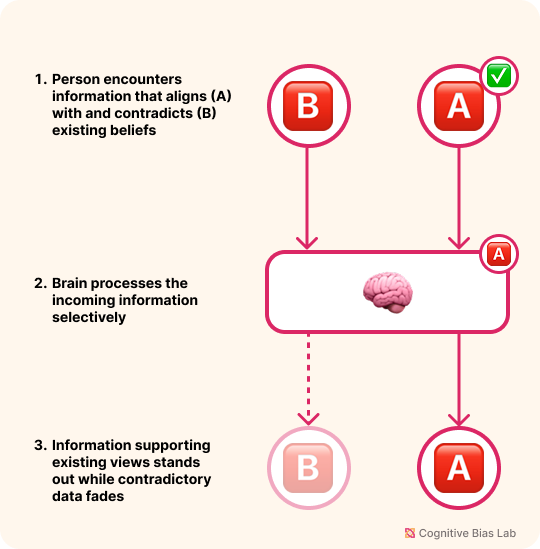Selective Perception
Your progress on this bias test won't be saved after you close your browser.
Understanding Selective Perception
Selective Perception
We naturally filter information through the lens of our existing beliefs, focusing on what confirms our views while conveniently overlooking contradictory evidence—even when it's right in front of us.
Overview
Selective perception is our tendency to interpret information in ways that reinforce our pre-existing beliefs and expectations. This powerful bias acts as a mental filter that highlights data supporting our worldview while subtly discarding or diminishing contradictory evidence.
Key Points:
- Your brain automatically filters incoming information through your existing cognitive framework
- This bias reinforces and perpetuates established beliefs, creating a self-reinforcing cycle
- Can lead to dangerously narrow decision-making, particularly in complex or ambiguous situations
- Often occurs below conscious awareness, making it especially difficult to counter
Impact: In professional settings, selective perception can sabotage sound judgment. A senior manager might unconsciously disregard critical market research that challenges their strategic vision simply because it conflicts with their preconceived ideas. Similarly, product teams relying on feedback from only familiar customer segments may miss crucial insights about broader market needs.
Practical Importance: Awareness of selective perception is essential for anyone aiming to make balanced, evidence-based decisions. By actively seeking diverse perspectives and critically evaluating all data—both supporting and contradictory—you can break free from the confines of your existing mental models and arrive at more robust, accurate conclusions.

Visual representation of Selective Perception (click to enlarge)
Examples of Selective Perception
Here are some real-world examples that demonstrate how this bias affects our thinking:
The Echo Chamber Effect
A marketing director presents research findings to the executive team. The CEO immediately highlights data points that support the company's current strategy while dismissing contradictory signals as "outliers" or "not representative of our core market." Despite clear warning signs about shifting consumer preferences, the company continues with its original plan and is blindsided when a competitor captures significant market share with a product addressing the very needs they ignored.
Performance Review Blindspot
A manager consistently rates a particular employee highly because of their strong performance in presentations. However, the manager overlooks documented issues with this employee's teamwork and deadline management because these contradict their perception of the employee as a star performer. This selective filtering creates team resentment and reinforces the problematic behavior, ultimately damaging both team dynamics and project outcomes.
How to Overcome Selective Perception
Here are strategies to help you recognize and overcome this bias:
Assign a Devil’s Advocate
Have someone argue against your position using real data to uncover blind spots before deciding.
Run a Pre-Mortem
Imagine your decision failed—then identify the reasons why. This reveals risks you might be ignoring.
Test Your Understanding
Challenge yourself with these questions to see how well you understand this cognitive bias:
A product manager conducts user testing for a new app feature. Early feedback is mixed, with 60% positive reactions and 40% negative. When reporting to stakeholders, they emphasize the positive feedback while briefly mentioning 'some concerns.' What cognitive error is occurring?
Academic References
- Bruner, J. S., & Postman, L. (1949). ON THE PERCEPTION OF INCONGRUITY: a PARADIGM. Journal of Personality, 18(2), 206–223.
- Kizilirmak, J. M., Glim, S., Darna, M., & Khader, P. H. (2021). Selective attention to stimulus representations in perception and memory: commonalities and differences. Psychological Research, 86(1), 150–169. https://doi.org/10.1007/s00426-020-01469-z
- Parris, B. A., Kalanthroff, E., & Augustinova, M. (2025). EXPRESS: Editorial for the Special Issue entitled: Mechanisms of Control in Selective Attention tasks. Quarterly Journal of Experimental Psychology.